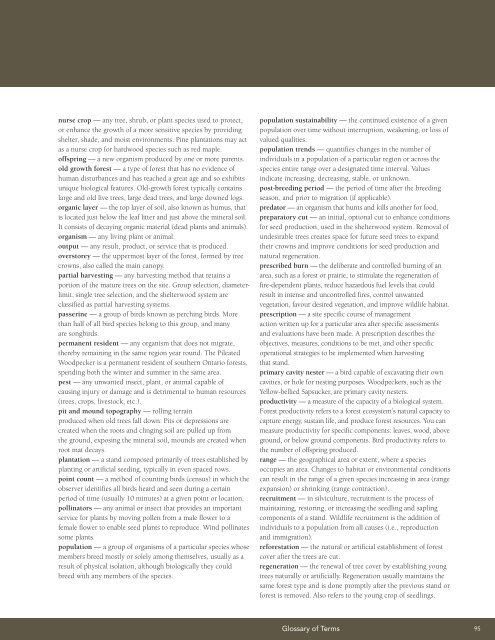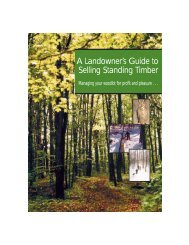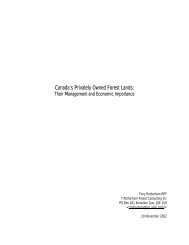A land manager's guide to conserving habitat for forest birds in ...
A land manager's guide to conserving habitat for forest birds in ...
A land manager's guide to conserving habitat for forest birds in ...
Create successful ePaper yourself
Turn your PDF publications into a flip-book with our unique Google optimized e-Paper software.
nurse crop — any tree, shrub, or plant species used <strong>to</strong> protect,<br />
or enhance the growth of a more sensitive species by provid<strong>in</strong>g<br />
shelter, shade, and moist environments. P<strong>in</strong>e plantations may act<br />
as a nurse crop <strong>for</strong> hardwood species such as red maple.<br />
offspr<strong>in</strong>g — a new organism produced by one or more parents.<br />
old growth <strong>for</strong>est — a type of <strong>for</strong>est that has no evidence of<br />
human disturbances and has reached a great age and so exhibits<br />
unique biological features. Old-growth <strong>for</strong>est typically conta<strong>in</strong>s<br />
large and old live trees, large dead trees, and large downed logs.<br />
organic layer — the <strong>to</strong>p layer of soil, also known as humus, that<br />
is located just below the leaf litter and just above the m<strong>in</strong>eral soil.<br />
It consists of decay<strong>in</strong>g organic material (dead plants and animals).<br />
organism — any liv<strong>in</strong>g plant or animal.<br />
output — any result, product, or service that is produced.<br />
overs<strong>to</strong>rey — the uppermost layer of the <strong>for</strong>est, <strong>for</strong>med by tree<br />
crowns, also called the ma<strong>in</strong> canopy.<br />
partial harvest<strong>in</strong>g — any harvest<strong>in</strong>g method that reta<strong>in</strong>s a<br />
portion of the mature trees on the site. Group selection, diameterlimit,<br />
s<strong>in</strong>gle tree selection, and the shelterwood system are<br />
classified as partial harvest<strong>in</strong>g systems.<br />
passer<strong>in</strong>e — a group of <strong>birds</strong> known as perch<strong>in</strong>g <strong>birds</strong>. More<br />
than half of all bird species belong <strong>to</strong> this group, and many<br />
are song<strong>birds</strong>.<br />
permanent resident — any organism that does not migrate,<br />
thereby rema<strong>in</strong><strong>in</strong>g <strong>in</strong> the same region year round. The Pileated<br />
Woodpecker is a permanent resident of southern Ontario <strong>for</strong>ests,<br />
spend<strong>in</strong>g both the w<strong>in</strong>ter and summer <strong>in</strong> the same area.<br />
pest — any unwanted <strong>in</strong>sect, plant, or animal capable of<br />
caus<strong>in</strong>g <strong>in</strong>jury or damage and is detrimental <strong>to</strong> human resources<br />
(trees, crops, lives<strong>to</strong>ck, etc.).<br />
pit and mound <strong>to</strong>pography — roll<strong>in</strong>g terra<strong>in</strong><br />
produced when old trees fall down. Pits or depressions are<br />
created when the roots and cl<strong>in</strong>g<strong>in</strong>g soil are pulled up from<br />
the ground, expos<strong>in</strong>g the m<strong>in</strong>eral soil, mounds are created when<br />
root mat decays.<br />
plantation — a stand composed primarily of trees established by<br />
plant<strong>in</strong>g or artificial seed<strong>in</strong>g, typically <strong>in</strong> even spaced rows.<br />
po<strong>in</strong>t count — a method of count<strong>in</strong>g <strong>birds</strong> (census) <strong>in</strong> which the<br />
observer identifies all <strong>birds</strong> heard and seen dur<strong>in</strong>g a certa<strong>in</strong><br />
period of time (usually 10 m<strong>in</strong>utes) at a given po<strong>in</strong>t or location.<br />
poll<strong>in</strong>a<strong>to</strong>rs — any animal or <strong>in</strong>sect that provides an important<br />
service <strong>for</strong> plants by mov<strong>in</strong>g pollen from a male flower <strong>to</strong> a<br />
female flower <strong>to</strong> enable seed plants <strong>to</strong> reproduce. W<strong>in</strong>d poll<strong>in</strong>ates<br />
some plants.<br />
population — a group of organisms of a particular species whose<br />
members breed mostly or solely among themselves, usually as a<br />
result of physical isolation, although biologically they could<br />
breed with any members of the species.<br />
population susta<strong>in</strong>ability — the cont<strong>in</strong>ued existence of a given<br />
population over time without <strong>in</strong>terruption, weaken<strong>in</strong>g, or loss of<br />
valued qualities.<br />
population trends — quantifies changes <strong>in</strong> the number of<br />
<strong>in</strong>dividuals <strong>in</strong> a population of a particular region or across the<br />
species entire range over a designated time <strong>in</strong>terval. Values<br />
<strong>in</strong>dicate <strong>in</strong>creas<strong>in</strong>g, decreas<strong>in</strong>g, stable, or unknown.<br />
post-breed<strong>in</strong>g period — the period of time after the breed<strong>in</strong>g<br />
season, and prior <strong>to</strong> migration (if applicable).<br />
preda<strong>to</strong>r — an organism that hunts and kills another <strong>for</strong> food.<br />
prepara<strong>to</strong>ry cut — an <strong>in</strong>itial, optional cut <strong>to</strong> enhance conditions<br />
<strong>for</strong> seed production, used <strong>in</strong> the shelterwood system. Removal of<br />
undesirable trees creates space <strong>for</strong> future seed trees <strong>to</strong> expand<br />
their crowns and improve conditions <strong>for</strong> seed production and<br />
natural regeneration.<br />
prescribed burn — the deliberate and controlled burn<strong>in</strong>g of an<br />
area, such as a <strong>for</strong>est or prairie, <strong>to</strong> stimulate the regeneration of<br />
fire-dependent plants, reduce hazardous fuel levels that could<br />
result <strong>in</strong> <strong>in</strong>tense and uncontrolled fires, control unwanted<br />
vegetation, favour desired vegetation, and improve wildlife <strong>habitat</strong>.<br />
prescription — a site specific course of management<br />
action written up <strong>for</strong> a particular area after specific assessments<br />
and evaluations have been made. A prescription describes the<br />
objectives, measures, conditions <strong>to</strong> be met, and other specific<br />
operational strategies <strong>to</strong> be implemented when harvest<strong>in</strong>g<br />
that stand.<br />
primary cavity nester — a bird capable of excavat<strong>in</strong>g their own<br />
cavities, or hole <strong>for</strong> nest<strong>in</strong>g purposes. Woodpeckers, such as the<br />
Yellow-bellied Sapsucker, are primary cavity nesters.<br />
productivity — a measure of the capacity of a biological system.<br />
Forest productivity refers <strong>to</strong> a <strong>for</strong>est ecosystem’s natural capacity <strong>to</strong><br />
capture energy, susta<strong>in</strong> life, and produce <strong>for</strong>est resources. You can<br />
measure productivity <strong>for</strong> specific components: leaves, wood, above<br />
ground, or below ground components. Bird productivity refers <strong>to</strong><br />
the number of offspr<strong>in</strong>g produced.<br />
range — the geographical area or extent, where a species<br />
occupies an area. Changes <strong>to</strong> <strong>habitat</strong> or environmental conditions<br />
can result <strong>in</strong> the range of a given species <strong>in</strong>creas<strong>in</strong>g <strong>in</strong> area (range<br />
expansion) or shr<strong>in</strong>k<strong>in</strong>g (range contraction).<br />
recruitment — <strong>in</strong> silviculture, recruitment is the process of<br />
ma<strong>in</strong>ta<strong>in</strong><strong>in</strong>g, res<strong>to</strong>r<strong>in</strong>g, or <strong>in</strong>creas<strong>in</strong>g the seedl<strong>in</strong>g and sapl<strong>in</strong>g<br />
components of a stand. Wildlife recruitment is the addition of<br />
<strong>in</strong>dividuals <strong>to</strong> a population from all causes (i.e., reproduction<br />
and immigration).<br />
re<strong>for</strong>estation — the natural or artificial establishment of <strong>for</strong>est<br />
cover after the trees are cut.<br />
regeneration — the renewal of tree cover by establish<strong>in</strong>g young<br />
trees naturally or artificially. Regeneration usually ma<strong>in</strong>ta<strong>in</strong>s the<br />
same <strong>for</strong>est type and is done promptly after the previous stand or<br />
<strong>for</strong>est is removed. Also refers <strong>to</strong> the young crop of seedl<strong>in</strong>gs.<br />
Glossary of Terms 95

















